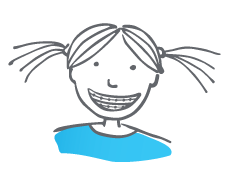Careful planning
for conditions that merit early intervention
Early treatment refers to orthodontic treatment started before the child has most or all of their adult teeth. In addition, early treatment most often occurs prior to the onset of the child’s pubertal growth spurt. This treatment is often geared towards correcting tooth and/or jaw malpositions, improving function, aesthetics and sometimes the self-confidence of the child.



When is Early Treatment recommended?
“Crossbite” of an anterior tooth causing gum recession, wear of the permanent tooth or shift of the lower jaw upon closure. This can be corrected with a removable retainer or braces cemented to select teeth;
Posterior “crossbites” resulting from a narrow upper jaw. Expansion of the upper jaw with an expander cemented to the upper teeth occurs rapidly over a 2-3 week period; the expander is often left in place for an additional 6 months for stabilization;
Impacted teeth or teeth that erupt away from their normal target. Occasionally, a short period of treatment is necessary to position incisor teeth in their proper position.
According to the Research
Orthodontic research in the last 15 years (References 1-2) has clearly shown that early treatment for “class II” problems (prominent upper front teeth or “buck teeth”) is of little value and may actually cause other problems.
Children undergoing two-phase treatment for class II problems often experience “burnout” from lengthy treatment. Other disadvantages can include increased cost, potential root resorption (“blunting” of the roots) and enamel decalcification or stains on the teeth.
Class II problems are best addressed during the child’s pubertal growth spurt, when the lower jaw is growing most rapidly. This time most often corresponds to when the child has most, if not all, of their adult teeth.
References:
1 Tulloch, Proffit, Phillips. Outcomes in a 2-phase randomized clinical trial of early class II treatment. American Journal of Orthodontics & Dentofacial Orthopedics. 125(6):657-667, June 2004
2 Harrison, O’Brien, Worthington. Orthodontic treatment for prominent upper front teeth in children. Cochrane Database of Systematic Reviews 2007, Issue 3. Art. No.: CD00345.DOI:10.1002/14651858.CD003452.pub2


